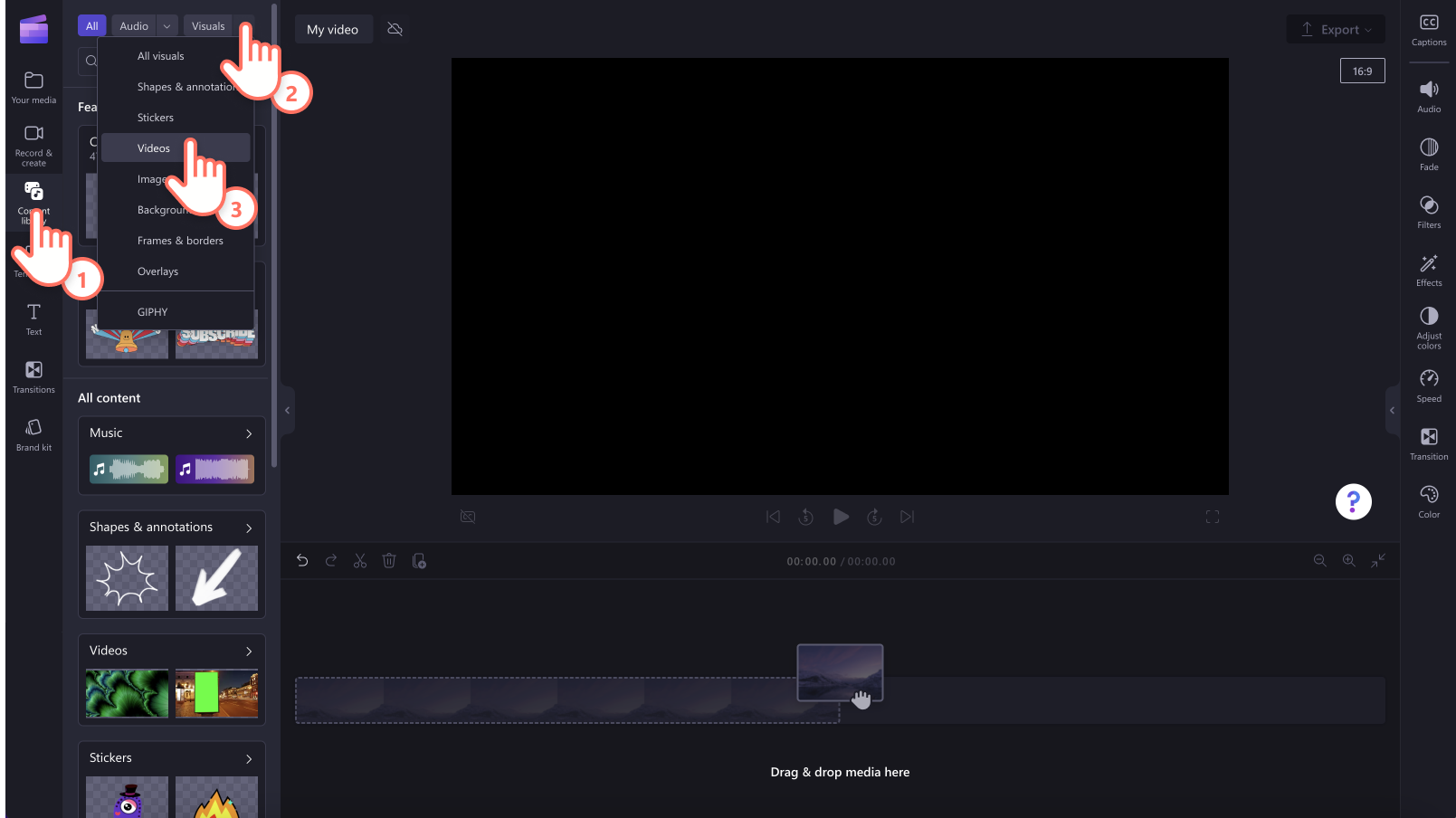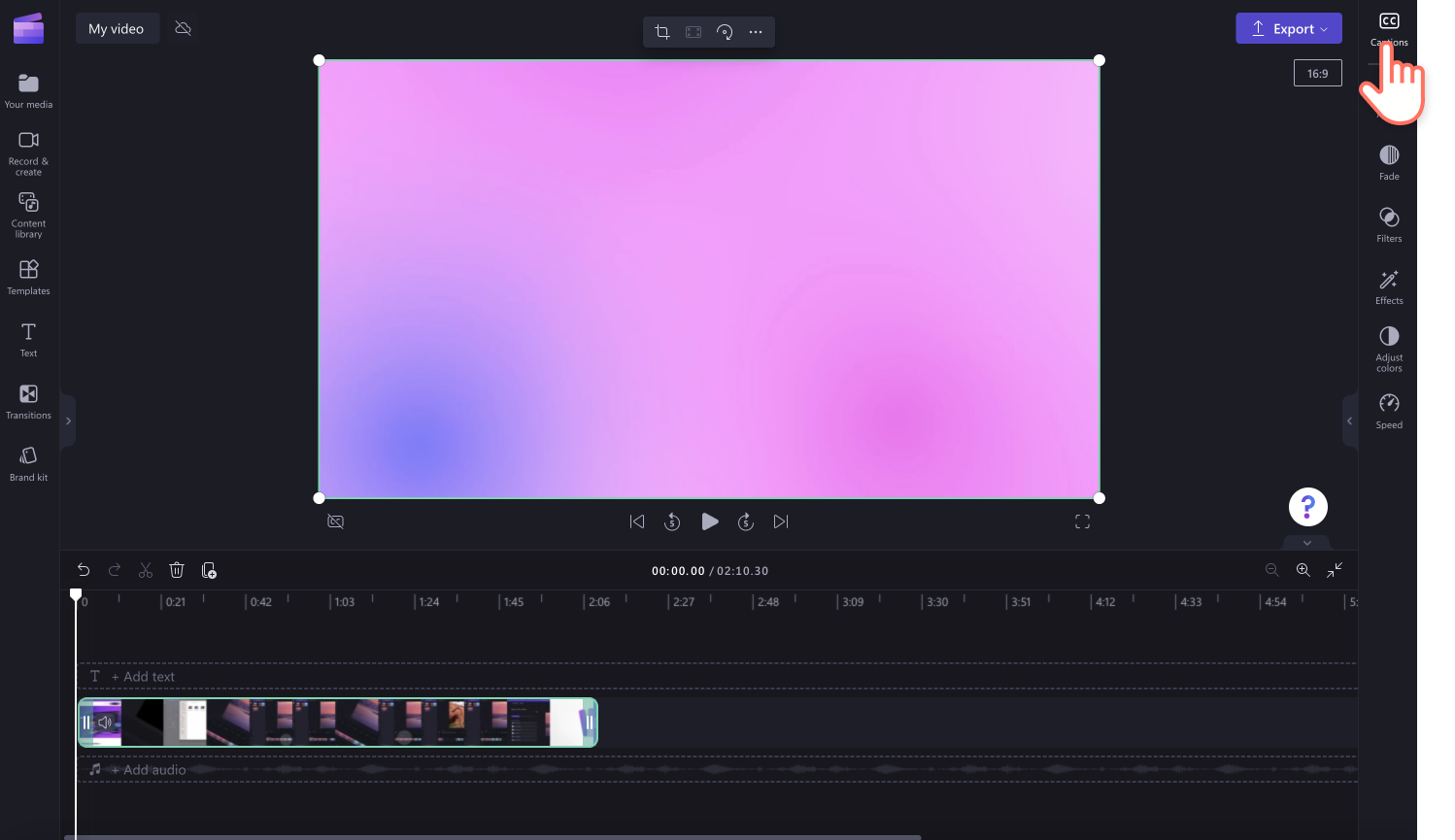Heads up! This content is relevant for Clipchamp for personal accounts. Try this link If you're looking for information about Clipchamp for work accounts.
On this page
Want to add subtitles to YouTube videos, slideshow presentations, or demo videos for free? Instead of hiring expensive freelancers to create a video transcript, save time, money, and add value to your videos with the autocaptions feature.
Whether you're creating a video for school, work, or social media, subtitles are a video editing essential. Subtitles make your videos easier to follow on mute, accessible to viewers with special needs, and inclusive for a global audience when available in multiple languages.
Read on to explore the benefits of subtitles and learn how to add subtitles to YouTube videos with Clipchamp.
How to add subtitles in Clipchamp
Step 1. Import videos or select stock footage
To import your own videos, photos, and audio, click on the import media button in the your media tab on the toolbar to browse your computer files, or connect your OneDrive.

You can also use free stock media like video clips, video backgrounds, and stock music. Click on the content library tab on the toolbar and click on the visuals drop down arrow, then videos. Search through the different stock categories using the search bar as well.

Drag and drop your video onto the timeline. To use the autocaptions feature, make sure your video has a voiceover or sound.

Step 2. Add subtitles using autocaptions
To add captions to your video, click on the captions tab on the property panel.

Once the captions tab is open, click on the turn on autocaptions button.

A popup window will appear with transcribing with AI options. Here, you can select which language you would like to use, and filter any profanity and offensive language by checking the box. When you’re ready to generate your subtitles, click on the transcribe media button.

You will automatically return to the editor and see your subtitle text being generated in the captions tab on the property panel. The generation time will depend on your internet connection, speed, and the length of your video.

Once your subtitles are generated, they'll appear as a transcript in the property panel and on the video preview window.

Step 3. Edit your transcript and customize appearence
Replace misspelt text
While our subtitle software is highly accurate, there’s a small chance that some words may be misspelt. Read through your transcript and type over the existing word to replace with the correct spelling.

Personalize the font, color, alignment, and size
To edit the appearance of your subtitles, click on your captions on the video preview. This will open up different options on the property panel. Next, click on the text tab on the property panel. Here, you can edit the font, size, alignment, colors, and position.

Step 4. Save your video with subtitles
Before saving your video, don't forget to download your SRT transcript file by clicking on the download captions button in the captions tab on the property panel. Your captions will download to your device.

Make sure to preview by clicking on the play button. When you’re ready to save, click on the export button and select a video resolution. We recommend saving all videos in 1080p video resolution for the best quality. Paid subscribers can save in 4K video resolution.

For more help, check out our YouTube tutorial.
How to turn off or hide subtitles
If you no longer require your video to have subtitles, just follow the steps below.
Click on the captions tab on the property panel.
Click on the turn off autocaptions button in the captions tab.
Your video will now have no subtitles.
You can also toggle on the hide captions in video button if you only want a transcript without captions. For more help, check out our autocaptions tutorial.
4 benefits of adding subtitles to your videos
1. Improve video accessibility
Adding subtitles to any video creates inclusive content and gives the wider audiences like deaf or hard of hearing communities the ability to enjoy your videos. Those who prefer to watch videos on mute or have difficulty understanding accents and languages also greatly receive help from subtitles. Let viewers watch and consume video content in locations where sound is not always accessible or suitable with captions as well. Creating inclusivity improves your video’s reach and overall user experience too.
2. Increase user watch time
If you are looking to improve your video or YouTube channel engagement, try adding subtitles to videos. Viewers can better focus and immerse themselves in your content with the support of video captions. Subtitles can help with visual cues like subheadings, date and time, help follow the videos storyline, and create emphasis on important information.
3. Overcome any language or accent barriers
Sometimes videos can be hard to understand and comprehend due to language barriers or accent differences. Adding on-screen subtitles lets those viewers easily follow along by reading what is being said in the video, rather than relying on audio to understand your video’s message. Make subtitles in many different languages to cater to non-native speaking viewers and expand your audience across the world.
4. Boost your videos searchability and SEO
Subtitles also play a role in boosting how easy it is to find your video online, which is a part of search engine optimization (SEO) practices. Adding subtitles can help your video content get indexed and make it more discoverable through relevant keyword searches, adding to your click-through rates and increasing your content’s watch time.
5. Enhance viewers learning
If you're creating educational videos like tutorials, demo videos, or PowerPoint presentations, subtitles are the perfect way to aid your viewers learning and comprehension. Viewers might not always have access to headphones or are watching in loud surroundings, so subtitles can let them watch, listen, and read all at once.
Frequently asked questions
Can I generate subtitles in multiple languages in one video?
The autocaptions feature allows you to generate subtitles in one language per video.
Are captions the same as subtitles?
The purpose of subtitles is to convert the audio dialogues of a video into text, as well as translate the dialogue of a video into other languages. The purpose of captions is to generate dialogue text as well as include other program content, including sound effects, music, laughter, speaker identification and location. Closed captions can be turned off in a video, but open captions are embedded in the video.
Should I use captions or subtitles?
Both captions and subtitles serve different purposes to your video, and both add different value. Determine if you would like to translate the language that’s spoken in your video or add a text-based representation of all your video’s audio.
How to add subtitles to YouTube videos?
Before saving your YouTube video, add subtitles using the autocaptions feature. Once captions are added, save and upload your video directly to YouTube. For more help, check out the autocaptions help article.
For more video editing and recording tips, check out how to webcam record and how to trim videos.
Start editing today with Clipchamp or download the Clipchamp Windows app.



